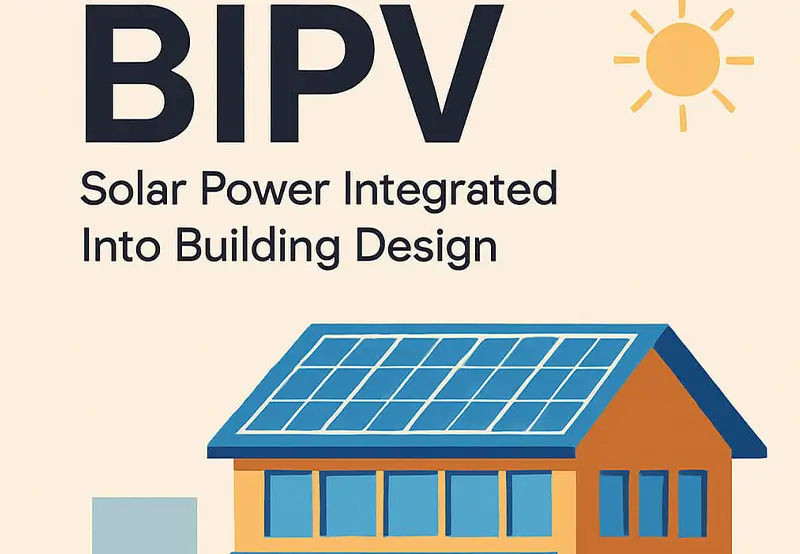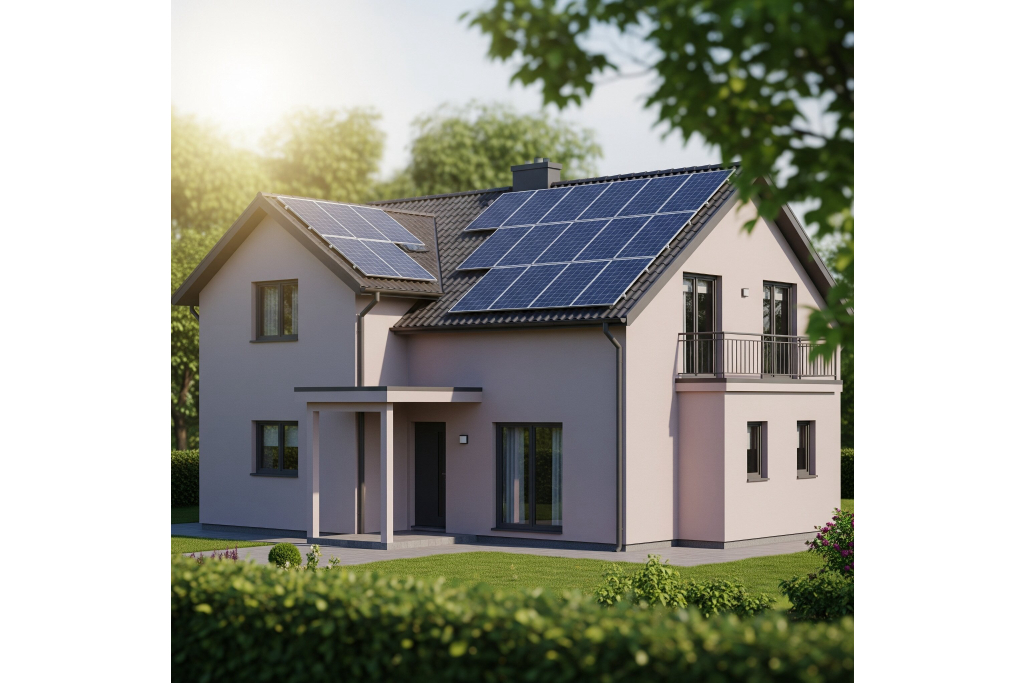BIPV: How Buildings Are Becoming Energy Generators
In pursuit of sustainable development and energy-efficient infrastructure, Building Integrated Photovoltaics (BIPV) has become a revolutionary technology. BIPV enables buildings to be more than a shelter by using the photovoltaic materials that make up the building itself and being a power generator. This is a fresh thinking that leads to a critical step towards net zero buildings whereby the consumption of energy will be dedicated to generation.

The Rise of BIPV Solar Panels
The emergence of BIPV solar panels is revolutionizing the building industry by providing a novel option for conventional building materials. Compared to conventional solar panels, which are most often mounted on the rooftops of buildings, BIPV solar panels are ingeniously integrated into the building envelope, such as facades, roofs, skylights, and windows. Their special benefit is twofold functionality—aside from producing clean electricity, they are also an alternative to traditional materials such as glass, tiles, or metal sheets. This combination brings both functional and beauty advantages, making energy production a seamless aspect of contemporary architecture. In a BIPV solar panel, buildings attain greater sustainability, increased design adaptability, and lower dependence on external supplies, reforming the future of green building.
Building Integrated Photovoltaics: The Future of Urban Architecture
Building Integrated Photovoltaics provide more than a green option; they redefine the notion of what a building is. Urban spaces, with their tightly packed buildings and high energy needs, are now looking to Building Integrated Photovoltaics as a way to cut their carbon footprint. Energy demand in the world is increasing on a daily basis and more people than ever before are demanding self-sustaining structures.
The incorporation of BIPV solar panels ensures a building receives solar energy during the day, and it is converted into usable power. Locality of production reduces dependence to external grid and stabilizes urban energy supply.
Solar Panels for Buildings: A Step Towards Energy Independence
The use of solar panels for buildings is a revolution in the way we look at construction and power. Historically, buildings have only been passive energy consumers. Now, with devices such as BIPV solar panels, they are turning themselves into micro power plants, selling electricity back to the grid or storing it for future use.
This innovation facilitates the construction of net zero buildings, where the energy used per year is approximately equivalent to the amount of on-site renewable energy produced. Developers and building owners can meet green building requirements while saving operational expenses in the long term by installing solar panels for buildings.
Net Zero Buildings: More Than a Buzzword
Net zero buildings are not a fad—they are a requirement in the era of climate change. Net zero buildings have energy efficiency strategies and renewable energy production, such as Building Integrated Photovoltaics, to reduce environmental footprint.
Net-zero status is important in the incorporation of BIPV solar technology. The BIPV systems reduce the use of fossil energy to harness the vibrant clean energy of the sun. Net zero buildings would also presumably be the rule, instead of exception, in new construction and other major renovation projects as the policies and incentives are progressing.
Aesthetic Appeal with BIPV Facade
The BIPV facade is one of the most ingenious applications of BIPV. In addition to offering a vertical source of power, facades offer visually appealing, modern effects to the building. The architects and designers can now be seen utilizing BIPV facade solutions to add more aesthetic value but do not grind down the specialized energy production ability.
Color, transparency, and texture of materials in a BIPV facade can be customized, giving limitless design possibilities. This customization brings in a sense of environmental performance and architectural completeness, which is very difficult to achieve when using the traditional solar panels.
BIPV Solar Technology: Bridging Design and Sustainability
BIPV solar technology is more than a clean energy solution; more like a meeting point between design, engineering, and sustainability. Unlike independent solar applications, BIPV solar technology is part of or manifests itself in the building as early as the architectural process. This has the consequence of leading to better efficiency, reduced material wastage and overall better performance of the life cycle of the building.
Secondly, BIPV solar technology is also more efficient in terms of thermal insulation and daylighting control and thus provides additional benefits boosting energy efficiency of the building. For instance, semi-transparent BIPV solar panels integrated into windows have the ability to filter light, minimize glare, and eliminate the use of artificial lighting during the day.
Economic Benefits of Building Integrated Photovoltaics
The use of Building Integrated Photovoltaics may, at first, seem more expensive than conventional material. But in the long term, the money saved is substantial. Buildings produce their own energy and thus slash electricity bills substantially. In a few areas, excess energy is even sold to the grid as a new income source.
Additionally, BIPV solar technology can boost property value. As there is an increasing need for green buildings, properties equipped with solar panels for buildings are considered better investment options. Incentives provided by the government, tax credits, and rebates also improve the economic benefit of Building Integrated Photovoltaics.
Environmental Impact of BIPV Systems
Environmental sustainability is at the heart of BIPV solar technology. By converting building surfaces into solar energy harvesters, we minimize the requirement for land-consuming solar farms. This is especially crucial in high-density urban areas where space is scarce.
Net zero buildings using BIPV solar panels are a valuable means of bringing down greenhouse gas emissions. Net zero buildings reduce the environmental strain from conventional ways of generating electricity, which utilize non-renewable resources to a large extent.
The Future Road for BIPV and Net Zero Buildings
With decarbonization and efficiency as the global trends, Building Integrated Photovoltaics will have a defining impact on the character of our cities. It requires concerted efforts among governments, architects, engineers, and developers to bring BIPV solar panels and other environmentally friendly technologies to a wide-scale acceptance.
From BIPV facade components to fully integrated solar BIPV technology, the construction industry is solar-powered, efficient, and sustainable. The revolution of our buildings from passive consumers to active producers is not visionary—it’s a reality today.
Conclusion
Building Integrated Photovoltaics, or BIPV, are transforming the building world by integrating energy production into architectural design as naturally as possible. With advancements such as the BIPV facade, building solar panels, and innovative BIPV solar technology, we are creating a future where buildings do not just sustain the environment but can sustain themselves. The charge toward net zero buildings is more than an aspiration—it’s a map to a cleaner, smarter, and more sustainable world.
Frequently Asked Questions (FAQs)
Building Integrated Photovoltaics are solar power-generating systems that are seamlessly integrated into the building envelope—such as facades, rooftops, or windows—serving both structural and energy-generating purposes.
BIPV solar panels are built into the building’s structure itself, unlike traditional panels that are mounted on existing roofs. They serve as part of the construction material while also generating clean electricity.
Yes, BIPV solar panels can be installed in residential, commercial, and industrial buildings. They are particularly beneficial in new constructions and renovations aiming to meet green building standards.
While the initial investment in solar panels for buildings may be higher, they offer long-term savings through reduced energy bills and increased property value. Incentives and rebates also help lower the overall cost.
Net zero buildings are structures that generate as much renewable energy as they consume annually, often using technologies like Building Integrated Photovoltaics to balance energy input and output.












